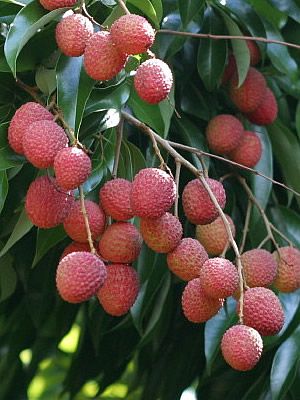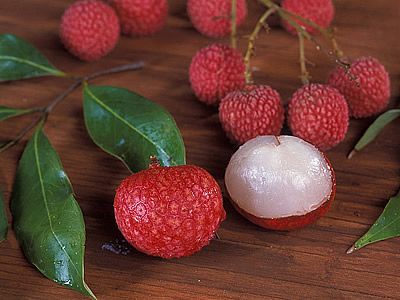Lychee (Litchi chinensis) is a fruit-bearing, evergreen, and ornamental tree native to tropical regions of Asia, known for its delicate and tasty fruits that resemble strawberries in appearance. With slow growth, it reaches a medium tree size, between 15 and 20 meters tall. Its canopy is broad, with a short trunk and branched, somewhat downward-curving limbs. The leaves are opposite, pinnate, with two to four pairs of coriaceous, elliptical leaflets, initially red-copper in color, turning bright green when mature.
It flowers in clusters in the spring, producing numerous small, fragrant flowers in white, yellow, or green. After pollination by insects, characteristic fruits form in the summer. These small fruits are ovoid or heart-shaped, with a rough, bumpy skin ranging from pink to reddish. The pulp is translucent, juicy, pearly, and sweet, with a delicious aroma, encasing a dark brown, inedible seed. There are three subspecies of the plant: Lichia chinensis chinensis, the most widespread and cultivated; L. chinensis javanensis, grown only in Malaysia and Indonesia; and L. chinensis philippinensis, which bears inedible fruits.

An excellent tree for the home orchard, the lychee, besides producing delicate and tasty fruits, is also ornamental and provides ample shade. The fruit can be consumed fresh, preserving its full aroma, or dried like raisins, as well as in preserves to be enjoyed throughout the year. Rich in vitamin C, it is used in dessert recipes, ice creams, yogurts, jellies, liqueurs, and even caipirinha.
Soon after harvesting, the fruits lose their vibrant red color and turn brownish, without compromising the flavor. The tree is hardy, and its management is not complicated. Initial formative pruning is important for facilitating canopy illumination and later fruit harvesting. Subsequent cleaning pruning, removing diseased and dead branches, keeps the plant healthy and productive. Drastic pruning can renew the productivity of old trees.
The lychee tree should be cultivated in full sun, in fertile, deep, drainable soil, enriched with organic matter, and irrigated during the first years of establishment. It prefers distinct climates, from subtropical to tropical, with a long rainy summer and some cold period in winter, important for stimulating flowering and fruiting in the following season. However, it does not tolerate frosts or intense cold, below -4°C (24.8°F), especially in young plants, which are quite sensitive.
Although it appreciates frequent watering, the lychee tree does not tolerate waterlogging, which quickly affects its roots, making it unsuitable for excessively wet or saline soils. Similarly, it does not adapt well to areas prone to droughts. It propagates by seeds, but more commonly by air layering and grafting, to preserve the characteristics of the mother variety.

